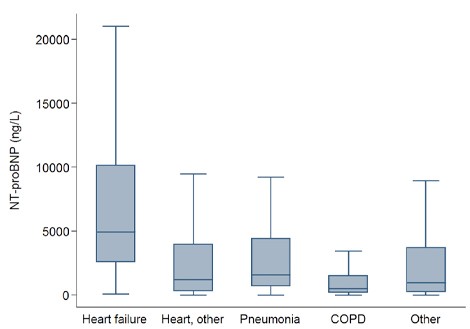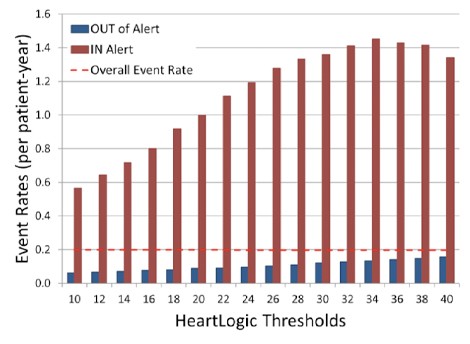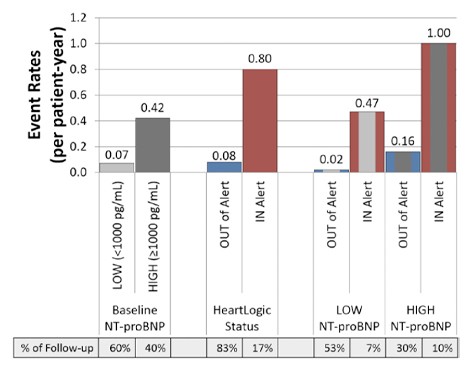Dear HeartLogic™ users,
In this issue we would like to deepen the correlation between HeartLogic algorithm and NT-proBNP biomarker for HF diagnosis.
You could find a brief summary about NT-proBNP and Heart Failure, a review of literature about HeartLogic and NT-proBNP, including the latest findings presented at Heart Failure Congresses, and a new case of the month.
NT-proBNP and Heart Failure
NT-proBNP & HeartLogic:
data from MultiSENSE
Gardner et al3 presented a post hoc evaluation using results from the MultiSENSE study and the HeartLogic index.
A total of 900 patients were analyzed:
- 145 HF events from 88 patients (0.20 events/pt-ys)
- 456 patients (51%) experiences at least one HeartLogic alert
- 120 patient –year IN ALERT state (17% of total patient-years follow-up)
Patients with HIGH baseline NT-proBNP when IN HeartLogic alert had a 50-fold higher event rate as compared to when patients with LOW baseline NT-proBNP when OUT of an alert state.
HeartLogic significantly augments the prognosis of a single snapshot NT-proBNP assessment at baseline for longer durations.
- HeartLogic identified patients at higher risk of an HF event independent of all baseline clinical measures, including NT-proBNP. - HeartLogic significantly enhances the risk stratification offered by a single snapshot NT-proBNP during the following year. |
NT-proBNP & HeartLogic:
latest findings
A new analysis from MultiSENSE study about the use of HeartLogic and NT-proBNP has been presented at ESC-HF 2019 as Late Breaking Clinical Trials.
“HeartLogic Performs as Well as NT-proBNP to Rule Out Acute Heart Failure at Point of Care”
– Gardner et al.
The purpose of the analysis was to compare the diagnostic accuracy of NT-proBNP and HeartLogic to rule out acute decompensated HF (ADHF) in acute settings.
Of the total 603 hospitalizations only 76 (52 HF, 24 non-HF) had both valid NT-proBNP measures within 48 hours of admission (71 within 24 hours), and valid HeartLogic value for the day before the hospitalization date.
HeartLogic-based ROC was similar to the ROC of NT-proBNP (AUC of 0.809 and 0.803, respectively, p=0.932).
An exclusion criterion of HeartLogic index <1 achieved the same performance as an NT-proBNP<300pg/ml
- When HeartLogic was <1 at admission (9 cases) or NT-proBNP <300 at admission (9), the adjudication was non-Heart Failure in 7 (0.778 NPV for both measures)
- Of 52 hospitalizations adjudicated as heart failure, thresholds were exceeded for HeartLogic in 50 and NT-proBNP in 50 (sensitivity 0.962 for both measures)
- Using either HeartLogic <1 or NT-proBNP < 300 at admission to rule out heart failure agreed with the adjudicated admission reason in 57 of 76 admissions (accuracy 75% for both measures)
The agreement between the two criteria was 84.2%.
Limiting the evaluation to 52 hospitalizations with acute dyspnoea (42 HF, 10 non-HF), the performance of HeartLogic and NT-proBNP were similar (p=0.906).
Expanding the evaluation of HeartLogic across all 467 hospitalizations with HeartLogic data (89 HF, 378 non-HF), performance was still similar (sensitivity 0.934, NPV 0.876 for the criterion of HeartLogic index <1; AUC of 0.734, p=0.166)
New data about the use of HeartLogic and NT-proBNP is going to be presented in the 2020 congresses... stay tuned! |
Case of the month
A 74 year-old man underwent implantation of PERCIVA™ ICD VR for primary prevention of sudden cardiac death on February 21, 2019.
HeartLogic™ was activated on April 25, 2019, and physician became aware that…





















